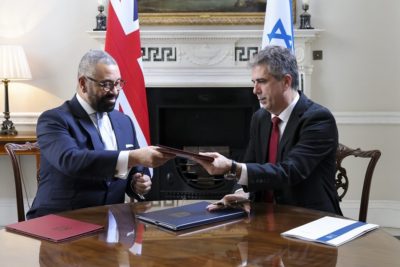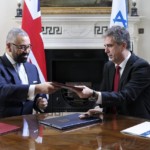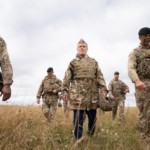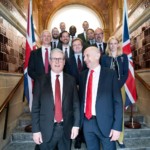Nuclear Weapons and Militarisation in the UK
ForcesWatch
A society has to be militarised for a government to justify the development and maintenance of nuclear weapons to its citizens; militarisation creates a culture of acceptance. It popularises military euphemisms such as ‘Defence’, ‘Security’, and – particularly relevant to nuclear weapons – ‘deterrent’, and makes it hard to for those challenging these to be seen as credible.
Militarisation’ means the ways in which the presence and approaches of the military (typically state armed forces and Defence Ministries) are normalised in a society. Military solutions are prioritised, and the military is privileged in various ways.
A society has to be militarised for a government to justify the development and maintenance of nuclear weapons to its citizens; militarisation creates a culture of acceptance. It popularises military euphemisms such as ‘Defence’, ‘Security’, and – particularly relevant to nuclear weapons – ‘deterrent’, and makes it hard to for those challenging these to be seen as credible.
The indicators of militarisation used in the Bonn International Centre for Conversion’s Global Militarisation Index 2012 are comparisons of: military expenditure with gross domestic product (GDP) and health expenditure; the total number of (para)military forces with physicians, and the overall population; and the number of ‘available’ heavy weapons with the total ppopulation.1 The UK was ranked 63rd out of 135 states, based on data from 2011.2 However, its expenditure on military activities (including armed forces and Ministry of Defence [MoD] personnel, operations, procurement, maintenance, and research and development) was the fourth highest in the world at $62.7 billion (3.6% of the global total, although not all of this was for its own military: at least £9.95 billion – around $15.5 billion – worth of military equipment was exported in the same year).3
However, the Index’s range of indicators is quite limited. In addition to overlooking other commonly-acknowledged indicators of militarisation such as the role of the military in government, and whether or not conscription exists, it does not examine the role of the military in everday life.
It is in this latter sense that the UK is militarised. Military personnel may have little visible influence in government, and apart from during the two World Wars we have only had conscription between 1945-1960, yet the military and its values have been noticeably promoted in many areas in the last five years. This perpetuates the UK’s self-perception that it has a special military status – 85% of the public believe that our Armed Forces are the best in the world, and 86% believe that we need strong Armed Forces – which is required for sustaining the claim that our continued possession of nuclear weapons is necessary and justifiable.4 Our military expenditure and capability are disproportionate to our economic standing; Germany and Japan – with far bigger GDPs – and Brazil and Italy (with similar ones) don’t have nuclear weapons. In 1954, Foreign Secretary Anthony Eden remarked during cabinet discussions in which the government decided to make its first nuclear bomb, that the “possession of a.[-tomic] weapons is now [a] measure of power & influence in the world”.5 Although largely unstated, the aspiration to retain world power status probably remains central to the decision to replace Trident.
How is the UK becoming more militarised? Many will have noticed the growing presence and influence of the military in UK society in recent years. Positive images of the military are promoted through policy and in the media. We are all being asked to support the armed forces through charitable giving and local community intiatives. The growing prominence given to the military was written into government policy five years ago. The 2008 report National Recognition of Our Armed Forces, written by Quentin Davies MP, Bill Clark (MoD), and Martin Sharp (RAF) for then-Prime Minister Gordon Brown, stated (based on surveys of the public) that the Armed Forces had ‘become increasingly separated from civilian life and consciousness.’, which could inhibit their ‘motivation and effectiveness’, potentially endangering ‘the society they are defending’.6 It asserted that ‘The Government therefore needs to make a continued effort to explain the rationale for the Armed Forces to the public’, and made forty recommendations for ‘increasing visibility’, ‘improving contact’, ‘building understanding’, and ‘encouraging support’, including, respectively:
-
encouraging members of the Armed Forces to wear their uniforms in public, making local authorities responsible for homecoming parades, and supporting the call for an Armed Forces Day
-
holding open days at military facilities
-
greatly expanding the Cadet Forces in state schools, and by introducing an Armed Forces element to the Citizenship curriculum
-
introducing special discounts for Armed Forces personnel
Almost all of these recommendations have been implemented, some under the Armed Forces Covenant, the legal formalisation in May 2011 of the supposed (but unwritten) contract between civilians and members of the Armed Forces, which ‘recognises that the whole nation has a moral obligation to members of the armed forces and their families and it establishes how they should expect to be treated.’7 The Armed Forces covenant encompasses the Community Covenant, which encourages local support for and interaction with Armed Forces personnel. Half of the UK’s local authorities had officially signed the Community Covenant as of the end of 2012; since then several more have signed.8 A recent example of a Community Covenant initiative is the call by Labour Party shadow ministers for more streets to be (re-)named after Armed Forces personnel killed in combat, which the London Borough of Barking and Dagenham have already started doing.9
The recommendations in the 2008 report are mostly about increasing the presence of the military in everyday life, seen in the statement ‘If military uniforms become more commonplace the Armed Forces will increasingly be seen as a normal part of society’.10 Other developments, particularly in the way that the military is giving access to young people within education and local communities, not only utilises the presence of the armed forces in the everyday life of young people to create positive influence over them and interest potential recruits but increasingly seeks to use military approaches as a solution to perceived social problems The militarisation of young people in particular
The 2005 Strategy for Delivery of MoD Youth Initiatives stated that ‘The principles underpinning the youth policy are:
a. to integrate Armed Forces Youth Policies with wider Government youth policies, particularly those aimed at capability building, social inclusion and citizenship;
b. to provide appropriately resourced university, combined and single service cadet units so that all youths have a reasonable opportunity to participate in cadet activities;
c. to provide an environment which maximises awareness of the Armed Forces among both young people and their gatekeepers in order to create the conditions in which recruiting flourishes.’11
The 2012 summary of the 2011Youth Engagement Review reiterated that the most significant benefits of running activities for young people are to defence rather than the young people themselves – ‘the two most important benefits to the MoD are awareness and recruitment.’, and ‘There is a definite benefit to the MoD of young people and the UK population as a whole being aware of the Armed Forces’.12
The military’s physical presence and its values are growing in schools: in addition to armed forces visits, lesson plans, and sixth form scholarships for potential officers, the Department for Education (DfE) is rolling out a ‘military ethos and skills’ programme in schools, which includes the £10.85 million expansion of the cadets in state schools (recommended in the 2008 report), and alternative provision for vulnerable, disengaged pupils, such as Challenger Troop – a full-time military-uniformed programme for 10-16 year olds, which is due to be greatly expanded.13 It is striking that whereas the MoD frames the outcomes of its youth policy in ‘defence’ terms, the DfE frames them as social outcomes.
There is considerable overlap between militarising initiatives in schools and in universities; there are university equivalents to the school scholarships, cadet forces, and recruitment stalls. Military-oriented research and teaching are quite common in universities’ Engineering, Science, and Technology departments, and also feature in some more surprising areas.14 The militarisation of research is particularly concerning. Approximately 17% UK’s current Research and Development (R&D) budget is allocated to military R&D. Although only a small fraction of this funding is channelled into universities, it ‘can shape the research priorities’ of the departments where it is particularly concentrated.15 The Sussex University academic Anna Stavrianakis frames this as the ‘instrumentalisation’ and ‘militarisation’ of higher education by the state and by corporations, where national interest and competition are emphasised, and the rightful public benefit and ‘autonomous space’ of higher education are overlooked.16 She has argued that ‘university involvement with arms companies’ (and, by extension, with the MoD) sees ‘the privileging of military concerns in the allocation of time and resources, which orients scientific and engineering research towards weapons production, encourages students to pursue militarised careers (such as engineering jobs with arms-producing companies), and discourages investment and innovation in the development of alternative technologies, all of which also contributes to the privileging of force as a means of resolving conflict and ordering social relations.’17 A Campaign Against the Arms Trade (CAAT) analysis of how nuclear weapons fit into the arms industry indicates the possible links with university-based research: ‘Arms companies, nuclear weapons and the military establishment go hand in hand…BAE is heavily involved in the development of the Trident replacement submarines’.18 Indeed, although a lot of the designing and building of Trident components seems to take place in industry rather than universities because of the security issue, a 2007 report by CAAT and Fellowship of Reconciliation revealed that AWE Plc funded forty-six military projects in the twenty-six UK universities it investigated (2% of the total number of projects).19An forthcoming Nuclear Information Service report will describe the range and nature of collaboration between AWE and a significant number of UK universities.
There are various other youth initiatives which specifically relate to Trident. The Atomic Weapons Establishment (AWE), which ‘on behalf of the Ministry of Defence’ manufacures and maintains Trident’s nuclear warheads, runs science demonstrations and competitions for secondary school students. Is there any mention of the horror of nuclear warfare during these events? The closest thing to it in recent press releases are references to the benign ‘vortex cannons’ and trebuchets that pupils get to use and design.20 The third photo down at http://tinyurl.com/cz6pd76 illustrates this. AWE school visits’ emphasis on non-military applications of science is similar to the problematic concept of ‘dual use’ – research which is essentially civilian but that can be used to develop and exploit military applications; it is difficult to criticise because its main purpose is civilian. Another example of encouraging the uncritical acceptance of Trident among young people are work experience placements with the Defence Fire Fighters at the Clyde naval base, site of the Trident submarines when they are not at sea.21
Last academic year the Defence Technical and Navy undergraduate bursary schemes, which commit students to a minimum of three years’ service after graduation, involved thirty-three Navy Technical students, and four Navy Engineers.22 Some of them may end up working on Trident; although it is unclear how much nuclear weapons research and development occurs at universities, AWE does actively seek to recruit talented Engineering, Physics and Chemistry graduates, and as usual the interesting science and opportunities are emphasised and the nuclear warheads are only mentioned fleetingly.23
One of the most objectionable things about many of militarising initiatives explored in this essay is that they do not give an honest impression of what war – the ultimate focus of militarism – is really like; neither school-based cadets, nor undergraduate Armed Forces bursars, nor any of the other young people involved, seem to be informed about the awful destruction that armed conflict causes. In the Trident-specific examples above, nuclear warfare appears to be ignored in the same way. .
The visibility and influence of the military in everyday life in the UK has increased significantly in the last few years, and this looks set to continue. A public which is sympathetic towards the military, and acccepting of military approaches, is less likely to be critical of our possession of nuclear weapons. The most recent public opinion poll on Trident, in 2010, suggested that 63% of people would back the non-renewal of Trident in order to reduced the national deficit – a slight increase on similar surveys in 2009 and 2006 – but it is not a very big majority, and the concern is the financial cost.24 Would a 2013 poll show less opposition to Trident, given that a lot of the initiatives described above have been rolled out since 2010?
The movement against the renewal of Trident could be strengthened by encouraging debate about militarisation in the UK.
by Owen Everett, QPSW Peaceworker at ForcesWatch and War Resisters’ International
6Quentin Davies MP, Bill Clark (MoD), and Martin Sharp (RAF), ‘National Recognition of Our Armed Forces’ (May 2008).
10Quentin Davies MP, Bill Clark (MoD), Martin Sharp (RAF), ‘National Recognition of Our Armed Forces’, 05/08.
See more: military in society, nuclear weapons










